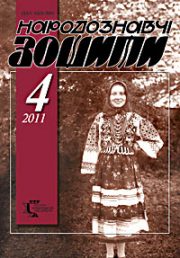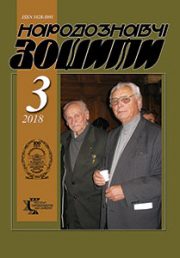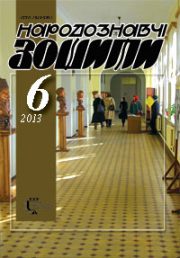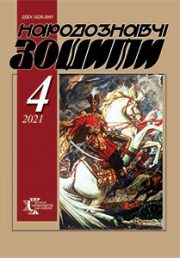The Ethnology Notebooks. 2019, № 3 (147), 641—659
UDK 39:371.72 (=161.2)(477.86)
DOI https://doi.org/10.15407/nz2019.03.641
TRADITIONAL ENVIRONMENTAL KNOWLEDGE, SANITARY AND HYGIENE ON POKUTTIA
TARAS Yaroslav
ORCID ID: https://orcid.org/0000-0001-7241-9466
Doctor of Historical Sciences, Professor Head of Ethnology Department Institute of Ethnology of the National Academy of Sciences of Ukraine,
Svobody Avenue 15, 79000, Lviv, Ukraine
Contacts: е-mail: etnomod@ukr.net
Abstract. Folk hygiene is an integral part of folk medicine. It has been formed for many centuries in order to protect people’s health, prevent diseases. Folk hygiene research was conducted by scientists in the past, in historical and ethnographic areas it was studied separatly. This issue was explored in the context of folk medicine of the XIX century by P. Chubinsky, A. Potebnya, M. Sumtsov, R. Kaindl, V. Shukhevich, in the XX century by A. Onyshchuk, S. Verkhratsky, N. Zaglada,Y. Bromley, Z. Boltarovich and M. Grinevich.
Despite the significant achievements in the study of folk hygiene, the great attention of ethnographers was given to its connection with the environment, how the protection estate is carried out of the house, how litter is removed and utilized.
It was clarified that the ecological and hygienic aspect at Pokuttia was present at all stages of the house construction, commercial buildings and their exploitation. First of all, the place for construction was given а great importance, the wood as a main material, the construction itself, the organization of the yard, the traditional system of life support in these buildings.
Particular attention is paid to the hygiene of the house, its cleaning during the week during the spring calendar ceremonies and the Great Calendar holidays.
An important hygienic event in Pokuttia was washing, which has its own history, it is primarily associated with the whitening of canvas. The general rules and technology of washing in the hollow, cadubus, and chains are disclosed; clarifications are made regarding the place and order of washing on the river, the laundry. The hygienic requirements for washing children’s clothes, women’s shirts, the mothers instructions for the daughters who went to the river, to the laundry, and the attitude of people to the sources of water were highlighted.
The hygienic aspect associated with water — washing, bathing, cleaning is fixed throughout Pokuttia, it is closely connected with folk and religious holidays, takes place in everyday life. The importance of washing in the river water in the Holy Week, before Christmas, on Ivan Kupala and washing in «Holy», «New Year», «Jordan». The hygienic actions of the hostess on the first day of the Lent and the custom do not carry the dishes from the old house to new one.
There was a rule in Pokuttia: everything that is connected with unclean: water after washing the children, washing the deceased, the patient, garbage, should be carried out in places where people and cattle do not go, it was forbidden for children to play on the Okapi. This place was assosiated with lice, mice, and rats.
In Pokuttia, national hygiene was directed as the protection of own and public health. Rational actions related to national hygiene in preventing diseases were taken over by official medicine, which destroyed irrational, that is, fuses, which under the «punishment of the higher forces» required them to comply.
Keywords: folk ecology, architecture, hygiene, pouctation, washing.
Received 22.04.2019
REFERENCES
Leru, R. (1970). Human Ecology — The Science of Housing Construction. Translated from french. Moscow: Strojyzdat [In Russian].
Romaniuk, Ya. (2012). Zaluchchia over Cheremosh. Historical and journalistic narrative. Sniatyn: Prut Prynt [In Ukrainian].
Kupchyns’kyj, B. (1994). History of Tishkovtsev (in dates, events and facts). Kolomyia: Vik [In Ukrainian].
Vasyl’chuk, M. (2013). About Velykyj Kliuchiv. Yamhoriv. Literary, ethnographic and artistic almanac. June, Ch. 22—23. P. 184—190 [In Ukrainian].
Zajshlyj, Ya. Society «Sil’s’kyj hospodar» cooperative institutions in Kolomyia. Kolomyia. TRK «Ridni mediia». Retrieved from: http://kolomyya.org/histpub/historypub78.htm [In Ukrainian].
Pan’kiv M. (2000). Agrarian relations in Pokutta and their social consequences in the second half of the XIX century — the first half of the XX century. Yamhoriv Literary, ethnographic and artistic almanac, 11—12, 185—198 [In Ukrainian].
Mrochko, Fr. K. (1977). Sniatynschyna: The causes of regional ethnography. Ditrojt, Ch. 1 [In Ukrainian].
Zubal’ Ya. (1975). Sadzhavka. In Al’manakh Stanislavivs’koi zemli (pp. 845—849). N’iu-Jork; Toronto; Miunkhen [In Ukrainian].
Bazhans’kyj, M. (1982). Beauty of Sniatynskii: rivers, streams, forests, meadows, gardens, towns and villages and high material and spiritual culture of their inhabitants: Haslova entsyklopediia. Ditrojt [In Ukrainian].
Zhajvoronok, V. (2006). Symbols of Ukrainian ethnoculture: dictionary-directory. Kyiv: Dovira [In Ukrainian].
Hnatiuk, V. (1912). Coming to Ukrainian Demonology. Ethnographic collection of NTSh. (T. XXXIV. Vyp. 2) [In Ukrainian].
Mokhoruk, D. (2008). My village is Toporovtsi. Ethnographic image of the village. Kosiv: The Sacred Stone. T. 6 [In Ukrainian].
Urbanovych, B. (1997). The artistic and figurative variability of the interior of the peasant household on Pokuttia. Yamhoriv Literary ethnographic and artistic almanac, 9–10 [In Ukrainian].
Demeniuk, D. (1988). Life and work in the village. In Kolomyia j Kolomyjschyna. Filiadel’fiia [In Ukrainian].
Kol’berh, O. (2006). Pokuttia. Ethnographic description. Proceedings. Ivano-Frankivs’k: Lileia-NV, 9—10, 306—333 [In Ukrainian].
Vajhel’, L. (2008). Essay on the city of Kolomyya. Kolomyia: Vik [In Ukrainian].
Marchuk, V. (2010). Torkovitsa. History pages. Ivano-Frankivs’k: LIK [In Ukrainian].
Taras, Ya. (2016). National ecology and hygiene on Polissya (based on expeditions 1994-2003). The Ethnology Notebooks, 2, 333–340 [in Ukrainian].
H. i P. T. (1988). Village Diat’kivtsi. In Kolomyia i Kolomyjschyna. Collection of memoirs and articles about the recent past. Filadel’fiia.
Makohon, I. (1978). Hlushkiv. In Horodenschyna. Historical memoir collection. Niu-Jork–Toronto–Vinnipeh.
Mokhoruk, D. (2005). My village Toporivtsi. Historical and ethnographic essay. Sniatyn: Prut Prynt [In Ukrainian].
Buchko, D. H. (1990). Origin of names of settlements of Pokuttia. L’viv: Svit [In Ukrainian].
Chaban, D. (1994). Village over strait Ribnitsa. Sniatyn: Nad Prutom [In Ukrainian].
B. i O. H. (1978). Horodnytsia. In Horodenschyna. Historical memoir collection. Niu-Jork–Toronto–Vinnipeh [In Ukrainian].
Mozoliuk K. (1988). Village Tovmachyk. In Kolomyia i Kolomyjschyna. Collection of memoirs and articles about the recent past. Filadel’fiia: Vydannia Komitetu kolomyian [In Ukrainian].
Roik Yu. (1978). Somewhat about Gorodenka. In Horodenshina. Historical memoir collection. Niu-Jork–Toronto–Vinnipeh [In Ukrainian].
Khotkevych H. Dovbush. Retrieved from: https://www.ukrlib.com.ua/books/printit.php?tid=5319.
Marunchak M. (1978). The village Dalesheva. In Horodenshina. Historical memoir collection (pp. 538–544). N’iu-Jork–Toronto–Vinnipeh [In Ukrainian].
Tymchuk, M. (1975). Grushka. Almanac of Stanislav land. Collection of materials for the history of Stanislav and region (pp. 899—908) . N’iu-Jork; Toronto; Miunkhen [In Ukrainian].
Shynkaruk, M. (1988). Village Ispas. In Kolomyia i Kolomyjschyna. Collection of memoirs and articles about the recent past. Filadel’fiia [In Ukrainian].
Serebryakova, O.H. (2013, 2014, 2016, 2017). Field materials from Pokuttia (Kolomyjsky, Gorodenkivsky, Tlumatsky, Tysmenitsky, Snyatinskyi district, Ivano-Frankivsk oblast) // Archive of the IN NANU (Archive of the Institute of Ethnology of the National Academy of Sciences of Ukraine). F. 1. Op. 2. Od. save 704. Arc. 1—489 [in Ukrainian].
Mykhajlets’kyj, O. (1912). Funeral practices and ordinances in. Trostyanets Snyatinsky district. Ethnographic collection of NTSh. (T. XXXII, pp. 302—315) [In Ukrainian].
Materials for the Ukrainian-Russian ethnology: 22 v. (Vol. V). (1902). L’viv [In Ukrainian].







